The era when lifting heavy objects needed hundreds of men is long gone. Now, winches do most of the work while humans are left with the easy part of just controlling them. Their strong ability to pull heavy objects that humans cannot; makes them part of our lives. As much as these winches are helpful, and they do the most work, humans still have parts to play to make it work.
So how does a winch work? How does this amazing harmony between humans and machines come into play?
Simply put, electrical and hydraulic winches, both the types work differently. The electrical winch works with a motor connected to a typically 12V battery, while the hydraulic winch works with hydraulic fluid ran by a hydraulic pump. They also have different use cases.
If you don’t know what a winch is used for, let’s help you learn about the uses of a winch and how each type works.
How Many Types of Winches There Are Available?
Winches are of different types, which are also separated into segments. The first segment separates the types of winches based on their operating system and their power source. Then the second segment distinguishes the types of winches by the way they work.
Types of Winches Based On Their Working Process
Depending on the work method, there are 3 types of winches. They are:
Snubbing Winch
This winch usually works vertically. They are mostly used by tow trucks and other means that require a slant winch movement. You won’t have any crank handle like a regular winch. They wrap the line of the winch around the spool and tighten or roll it by dragging the tail line.
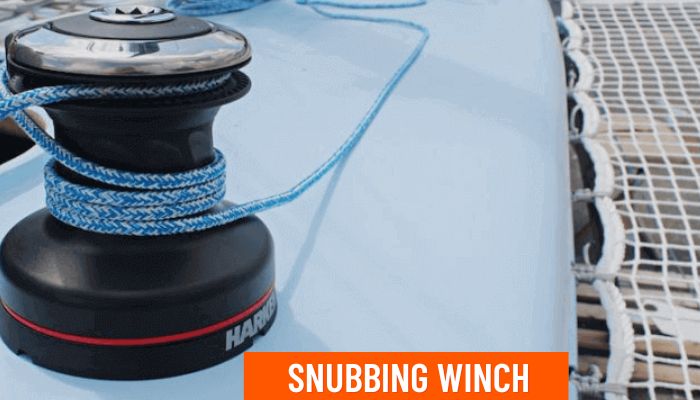
The operator of the winch can control the tension with the line’s friction around the spool. Small sailing boats also use this type of winch, and dinghies use it too.
Lever Winch
Unlike the snubbing winch that uses a spool, the lever winch uses a self-gripping jaw to move cable through it. You can use it to move weighty objects by moving the handle back and forth. The cable will spool in as you move the handle back and forth, aligning the jaw teeth for better grip.
Air Winch
The air winch is mostly used in aircraft to transport weighty and bulky things. People use it to lift and suspend an object in the air while they transport it to a different location. Also, people who exhibit bikes can use this, as they mostly suspend their bikes in the air for exhibition.
Types of Winches Based On Their Power Source
Power sources can vary from one type of winch to another. Depending on that, you can find 6 types of winches in the market as such:
Mechanical Capstan Winch
The mechanical capstan winch sources its operating power from an engine through the engine’s crankshaft. The crankshaft’s pulley connects to a dog clutch device and gets power. The mechanical capstan winch doesn’t work if the engine is not running.
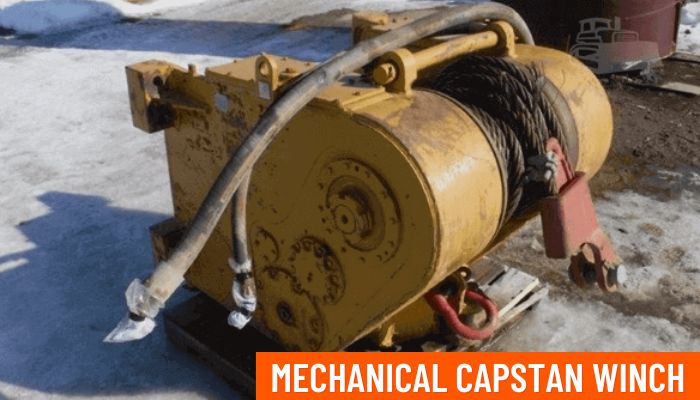
The assembly style of this winch is the only thing that distinguishes it from the mechanical drum winch. This winch has an extended piece that has the rope wrapped in an opposite direction from the way the drum winch has its rope.
Engaging the gears in the drum winch is not compulsory for it to work as it works when the engine is running. The shape of this assemblage of this winch gives it the name it bears. It has its rope wrapped over a holder that is like a spool.
Mechanical Hand-Operated Winch
The mechanical hand-operated winch is a wire rope that a series of clamps catch and release. This type of winch does not connect to any engine of any sort. Just one person operates it manually. It is an old-fashioned winch you’ll often see on flag poles.
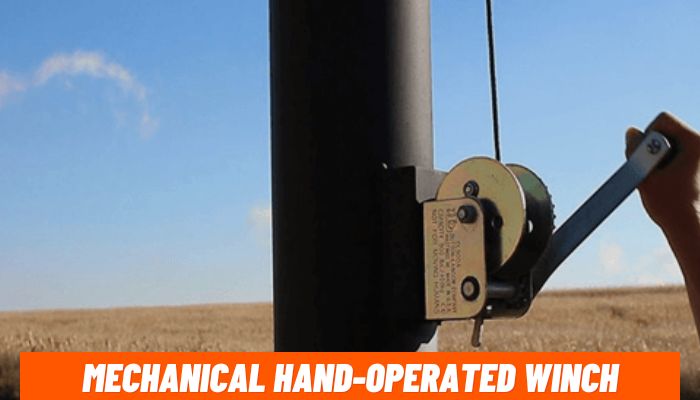
Mechanical Portable Winch
The mechanical portable winch is one that someone makes. This type of winch has a drum winch connected to a chainsaw motor with a hook for the provision of the motive force. Running this winch doesn’t have a connection to the vehicle it is hooked to, but it runs independently.
Mechanical Drum Winch
The power source of this is a running engine. Power transmits from gears when an operator turns it. The power goes to the winch through the turning shaft. Comparing this winch to an electrical winch will convince you that the drum winch is stronger. Also, it can work for more loads than the electrical winch.
Hydraulic Drum Winch
For the hydraulic drum winch, there is a connection through a hydraulic pump to the vehicle’s engine. Then, this sends power to the hydraulic motor. Also, the winch works when the engine is running.
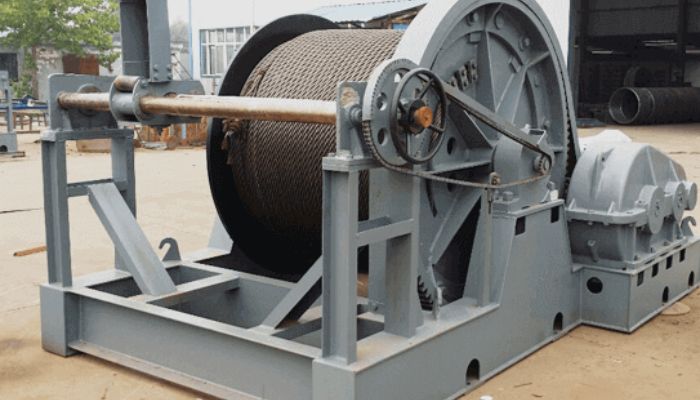
An interesting feature of the hydraulic drum winch is that water doesn’t affect it negatively. The winch is it still works perfectly even when you put it in water completely.
Electrical Winch
You can supply power to an electrical winch with the vehicle’s battery that is attached. Also, you can supply power to the winch with a battery you have set aside just for the winch. Using a separate battery for the winch is most preferred because sharing your vehicle battery with a winch might lessen the functionalities of your vehicle. Aside from this, you can get a 110v electric winch which is also effective.
How Does a Winch Work?
Now you know all the types of winches. Let’s discuss how does a winch work because knowing how it works is key to maximizing its use. To know how a winch work, you need to know the universal parts of a winch and the part each of them plays. Let’s guide you through the parts and their functions first.

- The Winch Drum: A winch has a drum that wraps the pulling and releasing cable around it. When the drum turns and gets more of the rope around itself, the object you are drawing gets closer and closer. When the drum turns in the opposite direction and releases the rope, the object it hooks goes further from it. Your drum should be big enough to contain the rope from whatever distance you pull the object.
- The Gear: There are many types of gears you can use to assist your pulling. When the object is heavier than what the winch can pull, the gear adds to pull the object. There are the elliptical or planetary gears and the worm gear.
- The Power: This has to do with what makes the winch works. The type of winch it determines what makes it work. So, using the hydraulic power method for an electric winch is not ideal. The winch will not work that way.
- The Motor: This is the vehicle that moves the winch from place to place. It also helps to move the object the winch pulled.
You can now know that you have to power the winch, hook it on an object and let the drum roll it in. If it is too heavy, apply the gear, and after the pulling, you can take it anywhere with the motor.
What Are The Uses of Winch?
A winch is a tool or device you can use to pull or lift objects that typically are too heavy for hand lifting. Also, people use winches to tighten cables for better use. The usage of winches started when Herodotus of Halicarnassus described when they used wooden winches to tighten the cables of a bridge across Hellespont back in 480 BC.

Earlier than 480BC, people also used winches in Assyria in the 4th century BC. Architectures used winches the most in the early times of their usage. You can apply winches in many ways, and they work perfectly for all. Let us go directly into the uses of winches in different applications.
For Aircraft Uses
Most times, when they launch gliders, they mount a winch on a heavy vehicle. The Europeans mostly use this method in their gliding clubs for aerotowing. Also, they equip rescue helicopters with winches to draw people into them or let out rescuers. This is mostly because it might not be too safe for the helicopter to land on the spot.

Some cargoes are just too big to contain in a craft, so the option is to airlift them. That is, hanging them with winches and allowing them to hover while the helicopter takes them to a dropping point.
For Theater Display
Theater directors mostly use winches for dramatic effect on their stage performances. They either use winches to lift actors to produce a flying effect or change positions of large pieces of the set to places they should be.
For Recovering Vehicles
In most cases, the difference between a tow truck and a regular truck is a winch. Here, they use winches to either disassemble vehicles or take them off their current position. They usually have hooks to hand on the vehicle and then drag the vehicle elsewhere. To disassemble the vehicle, two winches have to be connected to different parts of the vehicle and then pulled.
For Off-Road Vehicles
Most vehicles that go off-roading need to have winches in their front. This helps to get the vehicle out of a stuck situation when the wheels don’t come to work. Some off-road vehicles have winches at their back. They pull vehicles off mud, snow, water, sand, rocks, and even get out of other stronger hindrances.
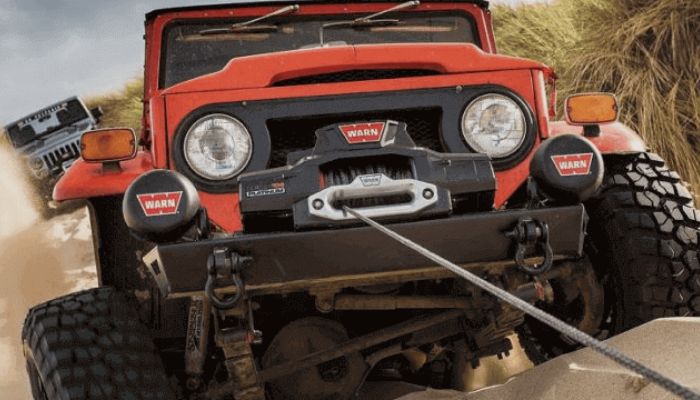
For Wakeskate Winching
Wakeskate winching is a game where someone on a skateboard gets thrust through the surface of the water with a winch. The person that the winch propelled will then swim or glide off it. The sportsperson holds onto a handle, followed by a rope, connected to the winch.
For Weighty Object Exhibition
This kind of exhibition is common amongst bike stores. Some bike stores use winches to exhibit their bikes for buyers to inspect every angle of the bike for assurance freely. When the shop owners are about to close, they make the winch move the bikes or other products to the top of the warehouse for safety.
Conclusion
We all know that winches are important in all kinds of heavy lifting, pulling, or rescuing. They come in handy to make things easier in almost all industries. Knowing how does a winch work enhance the possibility of getting the most out of it.
Now that you know how they work, you can apply one in the workshop to move heavy objects, tow cars, in aircraft, take cars out of mud, and many other advantages. However, while you do all these, you must ensure maximum safety. There are many safety practices while using winches from using the right tools to doing the job properly. Follow them well, stay safe and winch to the max!
Recent Posts
It’s relatively easier when you’re buying a brand-new winch as you can choose one with cable or rope pre-installed. But when you’re planning on replacing the current cable winch, you will...
Getting your winch cable snapped in the middle of nowhere is not an uncommon thing. If you’re not ready for such situations in prior, you won’t have an escape from there. So, knowing a few...
